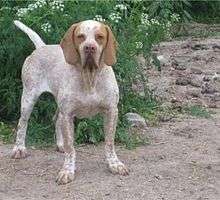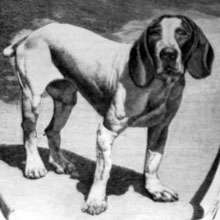Pachón Navarro
The Pachón Navarro (plural Pachones Navarros) is a Spanish breed of hunting dog from the autonomous community of Navarre, in northern Spain.
| Pachón Navarro | |||||||||||||||||||
|---|---|---|---|---|---|---|---|---|---|---|---|---|---|---|---|---|---|---|---|
 | |||||||||||||||||||
| Other names |
| ||||||||||||||||||
| Origin | Navarre, Spain | ||||||||||||||||||
| |||||||||||||||||||
| |||||||||||||||||||
| Dog (domestic dog) | |||||||||||||||||||
It was recognised by the Real Sociedad Canina in 1911, but by the 1960s was believed to be extinct. Efforts to recover the breed began in 1979;[2]:560 a breed standard was published by the government of Navarre in 2006, and in 2010 the Pachón was added to the list of dog breeds recognised by the Spanish government.[1][3] It is one of five Basque breeds of dog, the others being the Basque Shepherd Dog, the Erbi Txakur, the Villano de Las Encartaciones and the Villanuco de Las Encartaciones.[4][5] A few examples display an unusual characteristic, a split or bifid nose.[1]
History

The Fédération Cynologique Internationale and other major international kennel clubs do not recognize the Pachón as a standardized breed. The Spanish Kennel Club has accepted the Pachón as a breed.
The variety is thought to have descended from the Talbot hound and other hounds, originating in the 12th century. It is likely related to the Old Spanish Pointer, which it resembles in appearance.
The Pachón is believed to have reached its apex of popularity among Spanish nobility of the 18th and 19th centuries, becoming nearly extinct after the Spanish Civil War. A few enthusiasts scoured the country and have re-established breeding stock.
In 2009 the total breed population was estimated to be between 700 and 1000 dogs.[2]:560
Description
The modern Pachón is a braque-type hunting dog which points to game. It has short hair that may be brown and white, or orange and white, commonly ticked like the coat of most German Shorthaired Pointers. The head and large patches on the coat are generally solid-colored.
References
- [s.n.] (25 September 2006). Orden Foral 270/2006, de 14 de agosto, del Consejero de Agricultura, Ganadería y Alimentación, por la que se reconoce el estándar racial y funcional de la raza canina Pachón Navarro (in Spanish). Gobierno de Navarra/Nafarroako Gobernua. Boletín Oficial de Navarra 115
- Miguel Fernández Rodríguez, Mariano Gómez Fernández, Juan Vicente Delgado Bermejo, Silvia Adán Belmonte, Miguel Jiménez Cabras (eds.) (2009). Guía de campo de las razas autóctonas españolas (in Spanish). Madrid: Ministerio de Medio Ambiente y Medio Rural y Marino. ISBN 9788449109461.
- Elena Espinosa Mangana (4 March 2010). 4133: Orden ARM/573/2010, de 4 de marzo, por la que se modifica el anexo del Real Decreto 558/2001, de 25 de mayo, por el que se regula el reconocimiento oficial de las organizaciones o asociaciones de criadores de perros de raza pura (in Spanish). Boletín Oficial del Estado 62: 24841.
- Mariano Gómez Fernández (2002). Las razas de ganado autóctonas vascas en el pastoreo vaso (in Spanish). Annals del Centre d'Estudis Comarcals del Ripollès. 2002: 279–290.
- Mariano Gómez, I. Amezaga (2003). Conservation of livestock genetic resources in Euskadi (Basque Country). Animal Genetic Resources/Resources génétiques animales/Recursos genéticos animales 33: 41–55. ISSN 1014-2339.